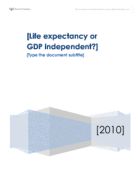r = ,,𝑆-𝑥𝑦.-,,𝑆-𝑥 .𝑆-𝑦 ..
,𝑆-𝑥𝑦.=∑𝑥𝑦,,∑𝑥.,∑𝑦.-𝑛.
,𝑆-𝑥𝑦. is known as the covariance of X and Y.
,𝑆-𝑥 .= ,-∑,𝑥-2.−,,(∑𝑥)-2.-𝑛..
,𝑆-𝑥 .is called the standard deviation of X.
,𝑆-𝑦 .= ,-∑,𝑦-2.−,(∑,𝑦-2.)-𝑛..
,𝑆-𝑦 .is the standard deviation of Y.
r=,∑𝑥𝑦− ,,∑𝑥.,∑𝑦.-𝑛.-,-∑,𝑥-2.−,,(∑𝑥)-2.-𝑛..,-∑,𝑦-2.−,(∑,𝑦-2.)-𝑛...
So, r = ,130013258−,,1707100.(7914.39)-115.-,-51470030000−,,(1707100)-2.-115..,-559261.8111−,,(7914.39)-2.-115...
=,12529300.01-161645.4262 ×120.7778847.
= ,12529300.01-19523192.65.
=0.6417649118
,𝑟-2.=0.4119
Interpretation of Results
Possible explanation for outliners (errors)
Correlation does not mean that there is a relation in GDP per capita to life expectancy because countries with low life expectancy are usually with some form of crisis. One would rarely see these in the higher life expectancy countries. Therefore, outliers are from the developing countries that are not only low in GDP but also other factors affecting it, such as war, disease, ‘brain drain’, economy crisis and so on. Even though the low GDP may be a contributing factor to the problem mentioned the impact that these crisis have on the countries are more pronounced in the life expectancy compared to GDP alone.
This form of GDP is used because… overall life expectancy rather than life expectancy at birth is used because…
One can see that the outliers of life expectancy 30-50 years old are usually from the developing countries such as Afghanistan, Zimbabwe, Rwanda, Ethiopia, Namibia, Niger, Nigeria and South Africa are of some trouble. For example,
Since the late 1970s Afghanistan has suffered continuous and brutal in addition to foreign interventions in the form of the 1979 and the 2001 that toppled the government.
Following the the United States launched , a military campaign to destroy the Al-Qaeda terrorist training camps inside Afghanistan.
Zimbabwe is experiencing a severe hard-currency shortage, which has led to .
In 2002, Zimbabwe was suspended from the on charges of abuses during the land redistribution and of .
Zimbabwe's current economic and food crisis, described by some observers as the country's worst humanitarian crisis since independence, has been attributed in varying degrees, to the government's price controls and land confiscations, the / epidemic, and a drought affecting the entire region.
Ethiopia has one of the fastest growing economies in the world, according to The Economist. Ethiopia has showed a fast growing annual GDP and it was the fastest growing non-oil dependent African nation in 2007 and 2008.
Although the bloody border war between Ethiopia and Eritrea (1998-2000) and food crisis.
Nigeria
The Nigerian health care system is continuously faced with a shortage of doctors known as '' due to the fact that many highly skilled Nigerian doctors emigrate to North America and Europe. In 1995, It was estimated that 21,000 Nigerian doctors were practicing in the United States alone, which about the same as the number of doctors working in the Nigerian public service. Retaining these expensively-trained professionals has been identified as one of the goals of the government.
Swaziland
Like many subsaharan African countries Swaziland is severely affected by the HIV and AIDS pandemic. In 2004, Swaziland acknowledged for the first time that it suffered an AIDS crisis, with 38.8% of tested pregnant women infected with HIV (see ). Prime Minister declared a humanitarian crisis due to the combined effect of drought, land degradation, increased poverty, and HIV/AIDS.
Sudan
clashes occurred in the western region of in the early 1970s between the tribes.
In July 2007, many parts of the country were devastated by ,
First Sudanese Civil War 1955 – 1972
Second Sudanese Civil War 1983 - 2005
Botswana
Congo, Republic of the
Gabon
Guinea-Bissau
Kenya
Lesotho
Mozambique
Somalia
Tanzania
Uganda
All these countries have some form of crisis or history of crisis such as war internally or externally, “brain drain”, HIV/AIDS, extreme poverty, hyperinflation, economic crisis, food crisis due to economy of natural disasters, geological location of the country being not very productive and so on.
Validity
The choice of sampling is systemic sampling because it avoids human nature of emotion and bias. Other form of sampling such as simple random sampling, stratified sampling, convenience sampling and so on are not used. When simple random sampling is used human emotions can interfere while choosing countries, although one may say they chose it in random there is always some form of bias. Furthermore, while choosing randomness of selection can result in a sample that doesn’t reflect the makeup of population or unlucky error. Stratified sampling is not used because it is difficult to categorise countries based on any characteristics. Convenience sampling is not used as it is not very scientific or systematic and human emotion interference causing bias.
The assumption made is that there is a linear correlation. However, the value of r turns out to be not very strong. During the interpretation of results the weak correlation was partially explained by factors such as war, food shortage, economic crisis, epidemic of diseases, and so on. I addition, it could well be that there is a non linear correlation instead. Furthermore, this method is extremely difficult and hence unable to test it.
Sex ratio is used to find if there is a significant difference in either population. This is to keep the result as accurate as possible although it may vary the result a little as there is some difference in gender in most countries.
Reference
(HDI)
HDI uses GDP as a part of its calculation and then factors in indicators of life expectancy and education levels.
(GDP? per capita (PPP))
(life expectancy)
(sex ratio)
(why GDP per capita (PPP))







